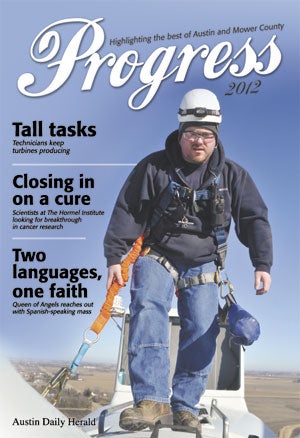21st Century school house
Published 11:24 am Tuesday, March 13, 2012
[imagebrowser id=2752]
Education takes new shape in Grand Meadow dome monoliths
This story originally appeared in Progress 2012. Get a copy at the Austin Daily Herald.
No, that isn’t an igloo complex you see as you drive through Grand Meadow — that’s Grand Meadow Public Schools.
The 103,000 square foot, 10-year-old school building is comprised of five monolithic domes that, according to Grand Meadow school officials, is much more efficient than the previous school building.
“It’s a little bit futuristic, even now,” said Marlin Fay, school board member.

This story appears in Progress 2012, which published Sunday, Feb. 26. Get a copy at the Austin Daily Herald.
The opportunity to build a domed school didn’t arise until the night more than a decade ago the school board was scheduled to approve school building renovations. Fay said the renovation project was ready to go, but the domed school seemed worthy of further research.
“I thought, ‘Wow, that’s really cool,’” Fay said. “Especially the environmental efficiency of it.”
The board decided not to vote on the renovation project that night, and soon the monolithic, windowless dome design was on the ballot.
Part of the appeal was the cost of constructing it. Price estimates indicated a domed school would cost $8 million to build, whereas the renovation alone would cost $6.5 million. On top of that, constructing a new conventional building would cost nearly twice as much as the domed school.
“The efficiency of the building, the lower cost of the building … we basically let (the community) make up their minds,” Fay said.
Slinky fields forever
While the domed school’s computerized heating and cooling system is easier to run for Head Custodian Karl Hoefs, he said the efficiency of the system is the most impressive benefit.
“It’s kind of like a refrigerator,” Hoefs said. “When the air is on, you’re cooling the inside. Then you reverse it so the warm air is blowing inside and the cool air is blowing out.”
Because the warm air is generated by energy stored underground in 27 miles of underground piping — called slinky fields — it takes much less energy to heat the domes than a regular building. That also means less air is flowing into the school.
Principal Paul Besel said he noticed fewer allergy problems among students and faculty after they had been in the domed school a while.
“Our air quality is better in this building than the old building,” Fay said. “It’s so much more effective in moving air in and out.”
Storing heat underground saves energy because the ground maintains a temperature of about 50 degrees, so water only needs to be warmed by 20 degrees to heat the school. Because of this, the school district spends much less on natural gas. The electricity bill has increased, though, as a byproduct of using less natural gas.
In the 2008-2009 school year, the district spent $7,658 on natural gas.
“In the last year we were in the old school we used $26,000 (in natural gas) in one month,” Fay said. “The total package has paid off.”
Weathering the weather
Although some of the school’s teachers were apprehensive about losing their window views, the change has been positive.
Bob Brusse, fourth-grade teacher, said he had five windows in his old classroom. He doesn’t miss them, though, because the students are more focused.
“You don’t have that distraction,” Brusse said.
Plus, the school’s lack of windows adds to the building’s efficiency. There are fewer opportunities for a cold draft to sneak in without windows, and for natural light, three of the five domes have skylights.
If that wasn’t enough, the domes are built to sustain any kind of weather. In fact, the school is likely the safest place in Grand Meadow during a tornado.
“It’s built to sustain very high winds,” Besel said.
And while other buildings in Minnesota run the chance of a roof cave-in under heavy snow, Grand Meadow school officials don’t have to worry about that. Since the building is rounded, snow slides right off.
“It’ll withstand pretty near anything,” Fay said. “In the old building with a flat roof, we were fixing the roof every year, and that’s thousands of dollars.”
Increased accessibility
Brusse said the layout of the building alone has improved staff relations, because teachers are closer together. In the old school, some classrooms were on opposite ends of the building and on different floors, making it hard for teachers to interact.
Now, everyone is closer together and housed on the same floor.
“The staff has embraced it,” Brusse said. “In the elementary, if we need to talk to somebody, they’re right there. Really accessible. We’re all right there.”
Besel said it has brought a sense of community, which is particularly important for a small town where everyone knows each other.
“It’s not uncommon for me to walk down to the dome commons and see a group (of staff) chatting,” Besel said.





